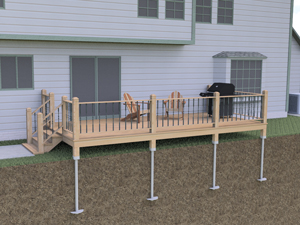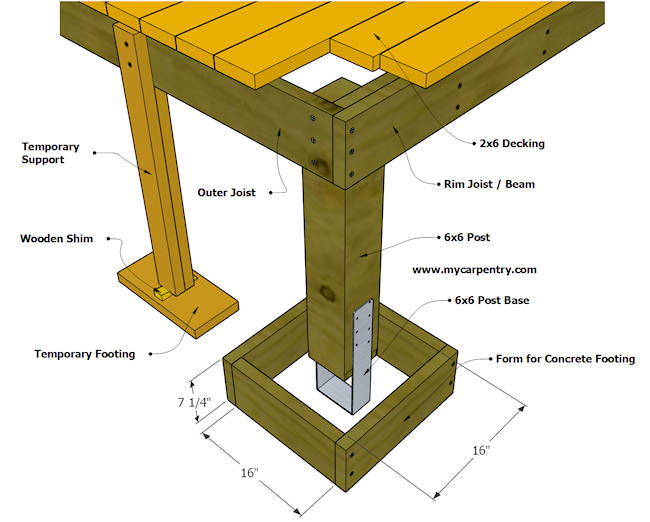Choosing the Right Deck Footings for Security and Durability
When it comes to developing a deck, among the most critical decisions you will certainly make is choosing the ideal footings for security and toughness. The long life and security of your deck depend greatly on the kind of grounds you choose, as they give the necessary support and security to stand up to the test of time. With a myriad of choices available, it can be frustrating to figure out which footings are best suited for your details requirements. In this conversation, we will certainly discover the various types of deck footings, take into consideration the essential factors to evaluate when deciding, and dig into the benefits and drawbacks of different choices. By the end, you will have a more clear understanding of the selections handy and be better outfitted to make an educated choice for your deck job.
Kinds Of Deck Footings
There are several types of deck grounds that can be made use of, each offering unique benefits and factors to consider. One common kind of ground is the concrete pier footing. These grounds include a round opening filled up with concrete, which supplies a strong structure for the deck blog posts. Concrete pier footings are fairly easy to install and offer exceptional stability, making them a prominent selection for several deck jobs.
These footings are installed by screwing them right into the ground, which creates a protected foundation for the deck. They likewise allow for very easy adjustment and progressing of the deck if required.
Additionally, some home builders go with precast concrete footings. These grounds are made from sturdy concrete and come in different forms and sizes to accommodate different deck styles. Precast concrete footings are practical to set up and provide a stable base for the deck framework.
Finally, an additional choice is the post-in-anchor footing system. This kind of footing includes driving a steel support right into the ground and attaching it to the deck article. It provides adaptability in regards to positioning the deck posts and is suitable for decks with light-weight structures.
When selecting the right kind of deck ground, it is important to think about variables such as soil conditions, deck lots, and regional building codes (Deck Footings). Consulting with an expert specialist or architectural engineer can help make sure the proper ground is selected for a stable and risk-free deck
Factors to Take Into Consideration When Selecting Footings
When choosing the proper footings for a deck, it is essential to very carefully consider numerous elements such as soil problems, deck load, and adherence to neighborhood building regulations. These variables play a significant function in ensuring the stability and durability of the deck structure.
The type of dirt on which the deck will certainly be developed determines the kind of footings called for. On the various other hand, decks developed on clay or expansive soils might need grounds that can accommodate the dirt's propensity to broaden and contract.
Another important factor is the deck tons. The weight of the deck, consisting of the products utilized and any prospective live lots such as furnishings or celebrations, should be taken into consideration when picking grounds. The grounds need to be made to birth the weight of the deck and disperse it equally to stop any kind of structural concerns or failings.
Last but not least, adherence to local structure codes is critical. Building ordinance vary from region to area, and it is vital to follow the details needs established by the regional authorities. Deck Footings. These codes guarantee that the deck is constructed safely and satisfies the required criteria for architectural integrity and load-bearing ability
Concrete Footings: Pros and Cons

When made use of as the structure for a deck,Concrete footings supply numerous advantages and drawbacks. On the positive side, concrete grounds provide exceptional security and toughness. Concrete is a rigid and strong material that can sustain hefty tons and stand up to various weather. It likewise has a long life-span, making it a reputable selection for lasting usage.
Another benefit of concrete grounds is their flexibility. They can be poured into different sizes and shapes to accommodate various deck designs and arrangements. Concrete footings can be personalized to fit the particular demands and requirements of the deck framework.
Nevertheless, there are likewise some drawbacks to making use of concrete grounds. One major downside is the cost and labor associated with their installation. Concrete grounds call for excavation and usually require the support of heavy equipment. This can enhance the total cost of the deck job and might require expert help.

Helical Piers Vs. Sonotubes: Which Is Much better?
In thinking about the foundation alternatives for a deck, the comparison between helical piers and sonotubes is essential in establishing the remarkable option. Helical piers, likewise called screw heaps, are steel shafts with helical plates affixed to them. They are twisted right into the ground utilizing hydraulic machinery, supplying a steady and durable foundation for the deck. On the various other hand, sonotubes are cylindrical forms made of cardboard or fiber product that are full of concrete. They are put in an opening dug right into the ground and give assistance for the deck.
When it involves stability and toughness, helical piers have the upper hand. The helical plates on the piers create a strong grasp with the soil, shifting or preventing any activity of the deck. This is specifically useful in areas with unpredictable or moving dirt conditions. Sonotubes, on the various other hand, count only on the concrete loading for security, which might not offer the same degree of stamina and resistance.
In terms of setup, helical piers are fairly go much easier and faster to install compared her explanation to sonotubes. The hydraulic equipment utilized to twist the piers into the ground makes certain a quick and effective procedure. Sonotubes, on the various other hand, require excavating openings and pouring concrete, which can be taxing and labor-intensive.
In addition, helical piers are a more functional option. If needed, they can be made use of in numerous dirt problems and can be changed or reinforced. Sonotubes, on the other hand, might need extra assistance, such as rebar, in particular soil problems or locations with high lots demands.
Picking the Right Footings for Your Deck's Measurements
For optimum structural honesty, it is necessary to thoroughly select the suitable grounds that straighten with the dimensions of your deck. The measurements of your deck, including its height, size, and width, play a substantial function in establishing the kind and dimension of footings required.
When picking grounds for your deck, it is essential to consider the load-bearing capacity of the dirt. The weight of the deck, incorporated with the weight of any type of furniture or people on it, applies a substantial pressure on the grounds (Deck Footings). It is essential to choose grounds that can effectively support this weight without sinking or changing over time.
The shapes and size of the grounds ought to additionally be thought about. Bigger decks with greater measurements call for larger grounds to provide adequate security and support. The form of the grounds, whether they browse around this web-site are square or round, depends upon the style and format of the deck. Additionally, the depth at which the grounds are installed must be determined based on the frost line in your region to prevent any heaving or changing as a result of freezing temperatures.
Verdict
In conclusion, picking the ideal deck grounds is vital for making sure stability and resilience. Variables such as the type of grounds, the deck's measurements, and the pros and cons of various options ought to be thought about.
These footings consist of a round opening loaded with concrete, which gives a solid structure for the deck posts. Concrete pier footings are fairly very easy to set up and offer excellent stability, making them a prominent option for several deck jobs.
Precast concrete footings are convenient to install and offer a stable base for the deck framework.
It offers flexibility in terms of positioning the deck blog posts and is ideal for decks with light-weight structures.
Concrete footings use a number of advantages and downsides when utilized as the structure for a deck.